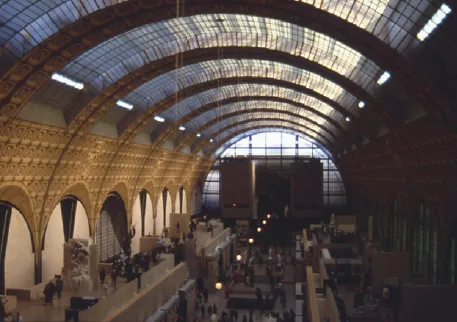INTRODUCTION
Roofs offer protection from the elements, but can also help exploit ambient energy sources and sinks, contributing to the space heating, cooling, ventilation and daylighting of buildings (Figs 1.1–1.2). The mainstream approach to roof design has emphasised the roof's protective function. This includes protection from sun, ambient temperature, wind, rain and snow. In most European countries building regulations enforce a prescriptive application of thermal insulation as a means of reducing the use of energy for space heating and cooling.
Though almost always necessary, protective mechanisms are not sufficient in themselves to make a building independent from conventional heating and cooling. To acquire such independence whilst achieving thermal comfort conditions for its occupants, a building requires suitable energy sinks for the dissipation of excess heat as well as renewable sources for space heating at other times. The latter are readily available from sunshine and from a building's internal heat gains due to occupancy. The permanent heat sinks are the ambient air, the ground, water masses and the sky when their temperatures are suitably lower than those of the spaces we aim to cool.
In this book we investigate the selective coupling of two of these heat sinks, the ambient air and sky, with roof elements aiming to provide heat dissipation and cooling for occupant thermal comfort. Roofs are generally the most exposed element of a building's external envelope. The balance between the protective and selective environmental functions of the roof is a function of temporal, as well as contextual parameters. The following topics are introduced in this chapter.
Protective functions
• solar control
• thermal insulation
• heat storage
Selective functions
• radiative cooling
• evaporative cooling
• convective cooling
• roof planting
Fig. 1.3 Solar and thermal processes on external and internal surfaces of a flat roof.
PROTECTIVE ENVIRONMENTAL FUNCTIONS
Solar Control
The roof is commonly the element of a building that is most exposed to the sun. Solar radiation absorbed by roof surfaces raises the surface temperatures, driving heat transfers toward the interior of buildings, as well as towards the ambient air and sky (Fig.1.3). The graph in Fig. 1.4 illustrates this by comparing the values of the air temperature on a typical summer day in Athens, Greece (obtained using the Meteonorm software**) with the temperatures of horizontal surfaces of solar absorptance 0.30 and 0.80, respectively*. It can be seen that the rise in the surface temperatures above that of the ambient air is a function of surface solar absorptance. The peaks in surface temperatures are affected by solar radiation which peaks at noon on horizontal surfaces, whereas the outdoor air temperature has its peak in the early afternoon hours. The drop in surface temperatures below the ambient air at night reflects the effect of radiative cooling, i.e. a net heat loss by long-wave radiation to the night sky.
Clearly, the design of a roof should seek to control the absorption of solar radiation and its effect indoors. This may be achieved by one or more of the following:
• suitable choice of orientation, tilt angle and surface area of roofs; these parameters affect the amount of incident solar radiation;
• light-coloured external finishing to reduce absorptance of solar radiation;
• shading of the roof to reduce incidence of direct solar radiation.
There are trade-offs between some of these parameters. For example, because of higher exposed surface area, a vaulted roof may receive more solar radiation than a flat roof in summer, but will also incur higher heat losses because of its higher exposure. It has been shown that the net difference may be quite small (Pearlmutter, 1993). A pitched roof tilted away from the sun receives less direct radiation than a horizontal roof; however, its larger surface area also results in greater exposure to diffuse radiation. The effect of surface colour on the absorption of solar energy is more clear-cut. Suitably maintained whitewashed roofs, whether flat or vaulted, have long been a feature of some Mediterranean cities because of their ability to reflect as much as 80% of the incident solar radiation (Fig. 1.5). Attention to the solar transmissivity of roof openings and awnings is essential to avoid glare and overheating (Figs 1.6 and 1.7). In regions with high levels of solar radiation, shading of the roof can provide an additional strategy. Shading can be provided by the layering of the roof construction, and/or by the use of additional external elements including use of vegetation (Fig. 1.8).
An indication of the effect of solar radiation on the external surface of an opaque building element is given by the sol-air temperature, an approximation of the external surface temperature derived from the following simplified expression.
where,
| tsa, | sol-air temperature, °C; |
| to, | ambient air temperature, °C; |
| α, | surface solar absorptance (dimensionless); |
| It, | total solar radiation incident on surface, W/m2; |
| ho, | external surface heat transfer coefficient*, W/m2K; |
| ε, | surface emittance (dimensionless); |
| ΔR, | net radiative exchange (difference between longwave radiation; received and emitted by surface), W/m2. |
As an example, consider a flat roof covered with grey tiles and exposed to an ambient air temperature of 35°C and incident global solar radiation of 800 W/m2. These are typical southern European conditions for a clear summer day around noon. The values of solar absorptance may vary from under 0.20 for very light-coloured, clean surfaces to over 0.90 for very dark or dirty surfaces. Assuming a solar absorptance of 0.70 for the grey tiles, a value of25 W/m2 K for the external surface heat tr...







